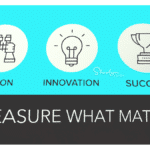We’re starting to hear a shift in conversation from engagement to retention. Organizations are getting concerned that their top talent is looking for new opportunities. It makes sense – it’s hard to engage an employee that’s thinking about leaving.
In my experience, when companies realize they need to focus on retention, they start to identify employees who are high potential and high performers. These are employees that companies want to retain. And these are employees that always have opportunities. It almost goes without saying that, if an employee is low performing and low potential, their resignation isn’t felt the same way as a high potential or high performer.
But high potential and high performer are two different things.
High performers are employees who deliver results. The company likes them for that reason. Give them a project and they make things happen. And for that same reason, high performers can often get a reputation for “leaving body bags” with the methods they choose to get things done.
High potential employees have, well, high potential. They are the future. They have many valuable skills that they company likes. But maybe they haven’t completely refined them. It’s possible that high potential employees have developed their skills to become high performing. They just aren’t quite there yet.
Both high performers and high potentials have their pros/cons. The question becomes which ones does the company want to retain? The natural answer would be to say “both!” but it’s possible the retention strategy for high potentials is different than that for high performers. I could see a high performer wanting rewards and recognition for delivering results. A high potential might be looking for professional development to get to the next level. Is the organization prepared to do both?
Companies will want to take a long look at their strategic plan and talent strategy to answer the question. High performers help the company achieve their goals today. High potentials will help the company achieve their goals in the future. High performers might help coach and mentor high potentials. None of this will happen without a well-thought out plan to engage and retain employees.
Image courtesy of HR Bartender








Bob Brady says
You raise such an important point when you say “None of this will happen without a well-thought out plan to engage and retain employees.” The topic of talent engagement will be one of the important issues for years to come. Retaining Talent is the way to create excellence and requires a program to identify talent, strengthen the capabilities of existing leaders and increase the number of people in the leadership pipeline.
Sharlyn Lauby says
So true, Bob. Thanks for the comment.
Rebecca says
I think the follow-up to this (the importance of a good employee retention plan) is finding out what really drives employees to stick with their companies or jump ship. According to a recent study published by Towers Watson, there five main drivers/motivators of employee engagement managers should be focused on: http://vingapp.com/employee-retention-plan-built-5-motivators/
Sharlyn Lauby says
Thanks for the comment and sharing the study!
Ewa says
Great insight – ideally it would be possible to adjust the retention strategy to both types, but it perhaps depends on the company’s strategy? For a startup for whom a rapid growth equals to be or not to be, retaining a fully-formed expert might be higher priority. Regardless, every company should have a plan to support employees’ growth at every level. It’s also crucial to collect ongoing feedback to notice a problem quickly before employee becomes dissatisfied.
Sharlyn Lauby says
Thanks for the comment Ewa. You raise a good point about remembering organizational life cycle when developing a strategy.
Kristen Harcourt says
Hi Sharlyn. Great post, I totally agree that a different approach is required for each; it’s interesting though, I define those two groups a bit differently.
At the McQuaig Institute, we define a high potential as someone who has the potential to move up in the organization at least two levels, whereas a high performer can be someone who is a specialist in their field, delivers great results, but doesn’t necessarily have what it takes to move into a leadership role.
The key difference is in the need for challenge and rewards.
While both want more challenge, high-potentials place high value on greater authority, responsibility for others, status and, of course, more money. It’s important that they see themselves as moving up the ladder. High-performers, on the other hand, will seek more challenge within their area of expertise. Authority and responsibility for others is not a motivational driver as they prefer consensus when making decisions and, to them, a promotion is not a reward. If you’re dealing with high potentials, there are five key things to consider in your development plan:
– Let them know you think they are High Potential
– Involve them in decision making
– Communicate with them to determine their goals and match company needs to their aspirations
– Give them assignments that require responsibility
– Cross train them across departments and allow them to balance their work and lifestyle
We wrote a blog about it too: http://blog.mcquaig.com/blog/the-difference-between-high-potentials-and-high-performers
Thanks for all the great posts Sharlyn, you always share such relevant insights!
Cheers,
Kristen
Luis says
Hi, i do usually think that you may be high performer while being a high potential as well and that is where the companies should focus all retention plans. I agree they aré differents but in my experience you need to help high performer to see a broader escenario, one in which they are allowed to deliver great results in their area but are open to continue learnig for greater challenges at a higher level
Raluca Bodkin says
I tend to agree with Ewa. Start-ups usually begin with a high budget and they tend to focus on high performers. But I also think that high performers in one area that are also high potential people in another area are the best way to go. A programmer who worked with different technologies but is also interested in design for example. It’ll be easier for him to communicate with marketing & creation people in the company and maybe take over some design tasks in the future, while still being the best at programming.